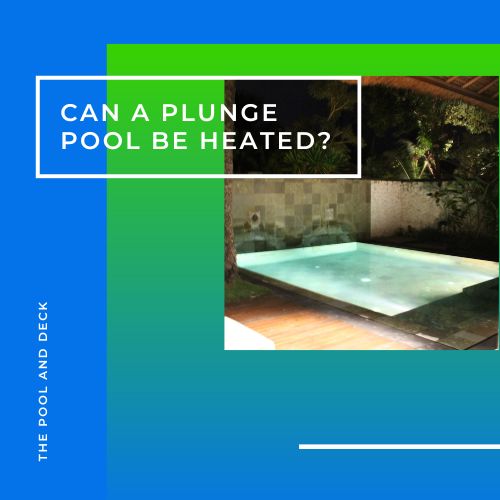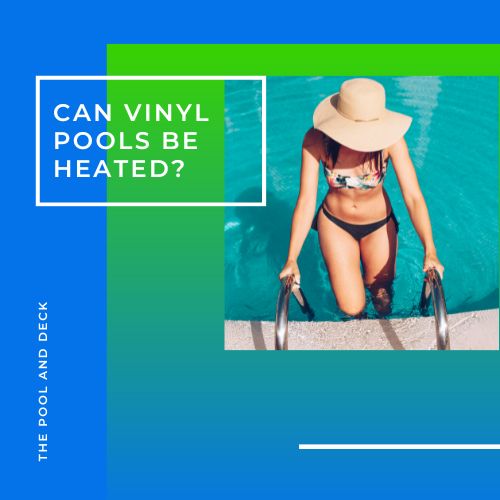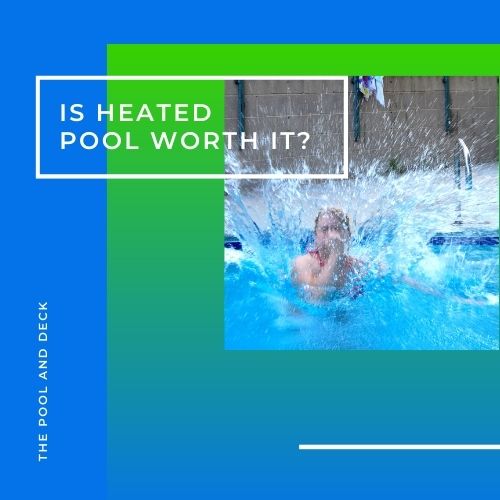Can a Plunge Pool Be Heated? (A Really Helpful Guide!)
thepoolanddeck.com is a participant in the Amazon Services LLC Associates Program, an affiliate advertising program designed to provide a means for sites to earn advertising fees by advertising and linking to Amazon.com . The website is also an affiliate of a few other brands. The affiliate links never increase your purchase price. We do appreciate your support. Thank you very much!
Table of Contents
Can a Plunge Pool Be Heated?
When backyard space is at a premium, a plunge pool is the perfect solution to your need to get into water and relax. Plunge pools are often thought to be cold pools, a perfect pairing with a hot sauna. So, can a plunge pool be heated?
It is a lot easier to heat a plunge pool because of its compact size. A typical plunge pool may be 10’ wide, 20’ long, 5’ deep and hold 7,500 gallons of water. Heating it by 10° F will take about 185 kWh of electricity at a cost of 24$.
Compare this with 15,000 gallons of water in a typical above ground and 30,000 gallons in a typical inground pool.
Keeping a plunge pool heated or cold is pretty much a personal choice. There are pros and cons of each. A cold plunge pool will invigorate the body, while a hot plunge pool will soothe & relax those tired muscles.

Since the plunge pool is small, it is possible to keep it at different temperatures at different times, during the day.
For example, you might like a dip in a cold plunge pool in the morning to feel fresh and energized for the day’s challenges. But you might prefer to relax in a warm plunge pool to soothe your aching muscles after a game of tennis, in the evening.
What Is the Point of a Plunge Pool?
If you do not already have a plunge pool but are thinking about getting one, then the obvious question is, “what is the point of a plunge pool”?
Possibly the most important reason for opting for a plunge pool is not having enough space to install a regular, family sized swimming pool.
The utility half of a plunge pool lies in its compactness.
A plunge pool could be built on site or purchased off the shelf and installed in the available space. Being compact it can be installed, almost anywhere; in your backyard, covered porch, indoors or even in a garage.
A plunge pool will give you almost all the benefits of a regular swimming pool except vigorous swimming or diving at the deep end.
But then many people do not want a pool just to do laps. They just want to get into a pool and chill. Relax and spend some quality time alone or with family & friends.
It is not to say that you can not use a plunge pool to work out. Water walking, pool edge push-ups, squats, aqua aerobics are just some on a long list.
The buoyancy of the plunge pool makes the exercises low impact and safe for the elderly or those suffering from muscular pain.
A heated plunge pool is totally worth it!
How Do You Heat a Plunge Pool?
You can heat a plunge pool by using one of the following 3 types of heaters:
- Electric Resistance Heaters or Heat Pumps
- Gas Fired Heaters
- Solar Powered Heaters
Each has their pros & cons. Find out more before you decide which one is best for you.
Electric Resistance Heater
An electric resistance heater uses a heating element to generate heat. The heating element converts electrical energy into heat energy by offering resistance to the flow of electricity.
The pros and cons of an electric resistance heater is as under:
| # | PROS | CONS |
| 1 | Independent of Outside Temperature | Low Efficiency |
| 2 | Compact Size | High Operating Cost |
| 3 | Quiet Operation | Low Heat Output |
| 4 | Low Initial Cost |
Electrical resistance heater is not an appealing choice to heat a plunge pool due to the low efficiency and high heating cost. The may work fine for a spa or hot tub with just 500 gallons of water though.
Electric Heat Pump
An electric heat pump works on the same principle as an air conditioner, just in reverse. A heat pump works by moving heat from one location to another.
Air is blown over an evaporator coil transferring the heat energy from the air to the refrigerant. The heat gain by the refrigerant is circulated to a condenser coil. Air blown over the condenser coil absorbs the heat. This heated air is then used to heat the plunge pool water.
The pros and cons of an electric heat pump is as under:
| # | PROS | CONS |
| 1 | High Efficiency | High Upfront Cost |
| 2 | Low Operating Cost | Long Heating Time |
| 3 | Long Life Span | Not effective when Temperature drops below 50° F |
| 4 | Ease of Installation |
An Electric Heat Pump is the most cost efficient, practical option for heating if you use your plunge pool often and for long durations, such as for hydrotherapy. It is best to run a heat pump continuously to further save on electricity costs.
Your plunge pool will be invitingly warm whenever you feel like getting in! Except when outside temperature drops below 50° F.
Want to know more about how to install an electric heat pump, check out my earlier post How Do You Heat a Concrete Pool? (Guaranteed Best Way!).
Gas Fired Heater
Gas Fired Heaters are a great choice if you are already using gas to heat your home. The initial cost is lower than an electric heat pump but the operating costs are much higher.
The most appealing advantage of a gas fired heater is that it can heat the plunge pool real fast!
The pros and cons of a gas fired heater for a plunge pool is as under:
| # | PROS | CONS |
| 1 | Lower Upfront Cost | High Operating Cost |
| 2 | Short Heating Time (Can heat a plunge pool in an hour) | Not Very Durable |
| 3 | Independent of Outside Temperature | High Maintenance |
If you need to heat up your plunge pool only occasionally and only for a few hours then a Gas Fired Heater is absolutely perfect for you. It works even during really cold winters and even when there is little or no sunlight!
The heater runs on propane or natural gas. So you need to hook it up to a backyard propane tank or a natural gas supply pipeline.
The heater is added to the pool circulation system after the pump and the filter. Heat is generated in the heater by burning gas. The heated water goes back to the pool.
A Gas Fired Heater is not the most cost effective or energy efficient option, but it gets the job done fast. To save operating costs, buy a model that has high efficiency.
Solar Powered Heater
A Solar Powered Heater harnesses the energy from the sun, which is free.
The only caveat is that you must be living in a zone which has plenty of sunlight during the day.
The design of the Solar Powered Heater can vary. For larger pools, rectangular solar panels, similar to those meant for house roofs, are used. For smaller pools, such as above ground or plunge pools, dome shaped Solar Powered Heaters are more convenient.
The pros and cons of a solar powered heater is as under:
| # | PROS | CONS |
| 1 | Free Energy | Slow to Heat the Plunge Pool |
| 2 | Long Lifespan | Weather Dependent |
| 3 | Eco Friendly | Low Heat Output |
| 4 | Low Maintenance |
The Mega SolarDOME works with your existing pool filter system. Using your existing filter system, water circulates through the solar panel, is heated by the sun and returns to the pool through the filter system raising your pool’s temperature up to 15 degrees.
The idea of a solar powered heater is quite compelling, as operating costs are negligible and the operation is highly eco friendly. However, practically speaking, they are unlikely to get your plunge pool hot enough, fast enough.
Better not to consider a solar power heater as a viable heating option for your plunge pool!
What Is the Best Heater For a Plunge Pool?
I recommend that you go for an electric heat pump. It is the cheapest to run and will keep your plunge pool heated to a comfortable temperature of 78-80° F, for most of the year.
Should you want to have a heated plunge pool in the cold winter months too, buy a propane heater as a backup. Use it only when the electric heat pump is unable to work or you want to heat up the plunge pool in a hurry!
NOTE: The recommendations are for the type of heater. Please make sure you get the right size for your plunge pool and a brand you can trust.
FAQ
What Is the Difference Between a Spool and Plunge Pool?
A spool, aka cocktail pool, is just a small pool, usually with a spa or a hot tub attached to it. The spool is used primarily for recreation, relaxation and socializing. They are typically just 3’-4’ deep and with seating for people to sit, talk and enjoy their drinks.
A plunge pool is designed to be more active. They are 4’-6’ deep so that you can perform aqua aerobics, water exercises, hydrotherapy, etc.
What Is the Difference Between a Hot Tub and Plunge Pool?
A Hot Tub, as the name suggests, is kept pretty hot (100-104° F). Soaking in a hot tub is a great way to soothe sore muscles.
Plunge pools are much larger and generally kept cold. A dip in a plunge pool will refresh and rejuvenate your body, especially first thing in the morning.
However, plunge pools can be heated too but the temperature is maintained at around 78° F. This is considered comfortable and relaxing.
What Is the Difference Between a Swim Spa and Plunge Pool?
The distinguishing feature of a swim spa is that it has a current, which keeps the swimmers in place. Swimming in a swim spa is the equivalent of running on a treadmill. You never hit the pool end.
Thank you very much for reading the post. I do hope you found it informative and helpful.






